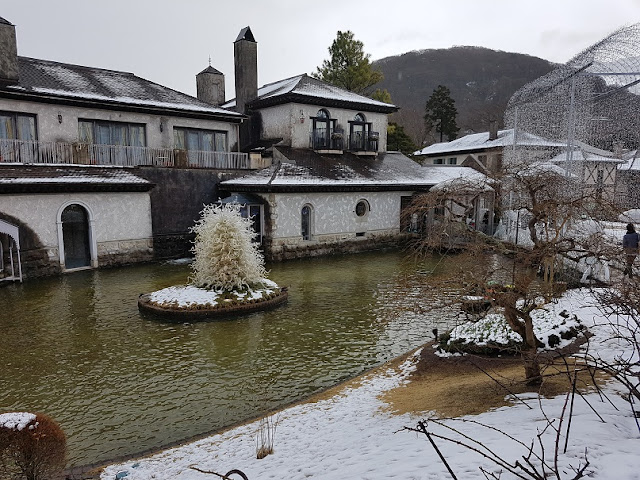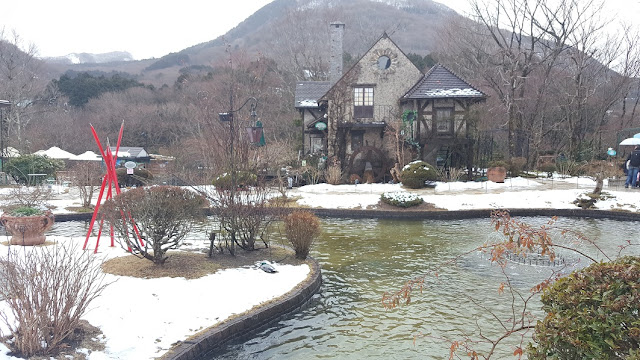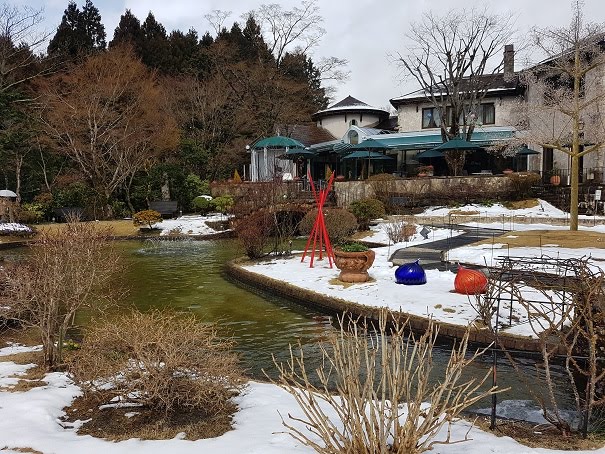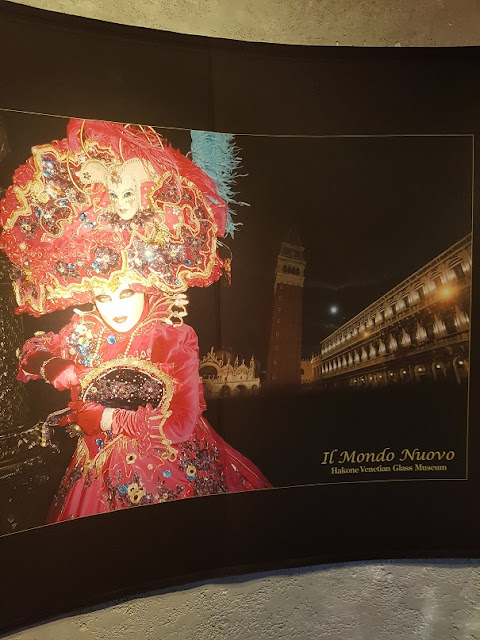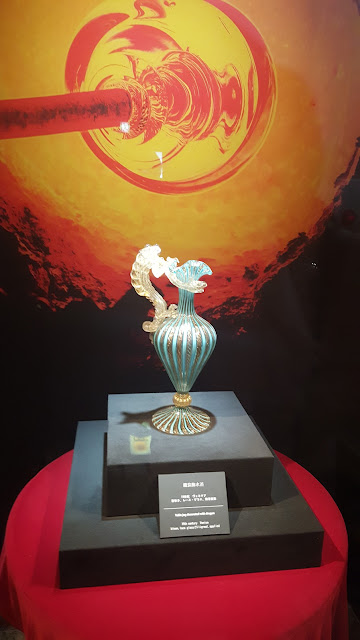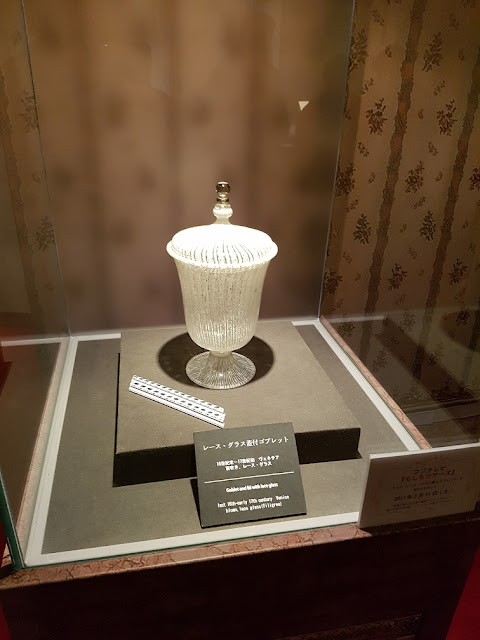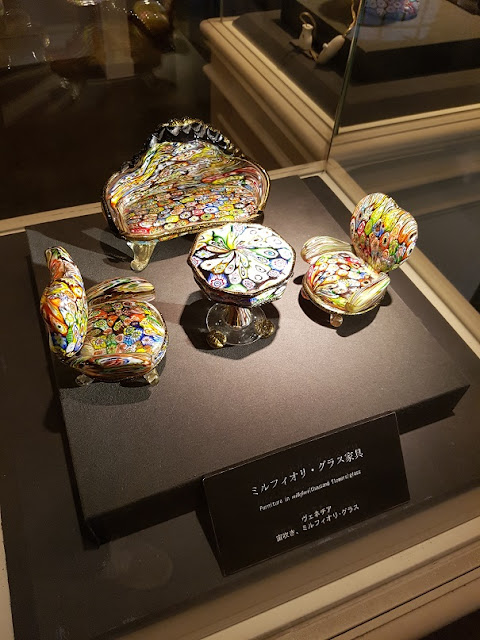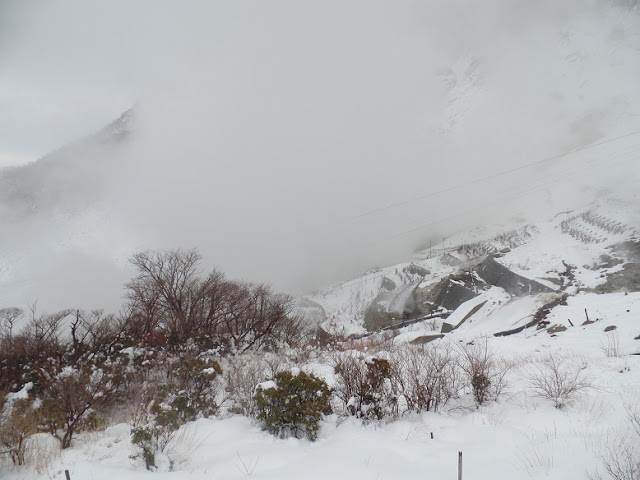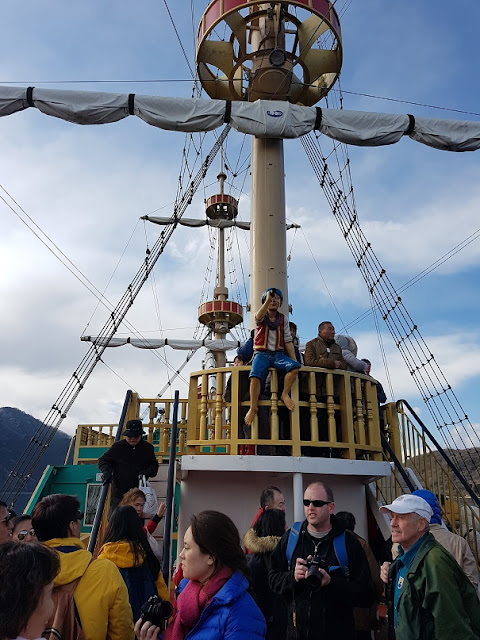On Day 2, we had to wake very early in the morning to prepare for check-out from our Airbnb apartment. In fact, we have stayed in the apartment for less than 12 hours only. We would be making a trip to Hakone (箱根), a mountainous area west of Tokyo (東京), which is famous for its hot springs (also known as "onsen"), volcanic valley and consist of various good spots to view Mount Fuji (富士山). After the check-out, we brought our luggage along and walked for a short distance to the Okachimachi JR Station (御徒町駅). At the manned gate, we activated the first use of our JR Pass, which the station staff would put a stamp on the pass to indicate the first use. From there, we took the train to the Tokyo Station (東京駅) via the JR Yamanote Line.
The Tokyo Station (東京駅) is one of Japan's busiest transportation hub, which is served by several Shinkansen lines, local JR lines, metro lines and buses. No doubt, the station is a very big place packed with fast paced travelers going to work in the morning. It took us some time to figure out which track to go to board our Shinkansen train. We waited at the platform for our Shinkansen Hikari train to arrive. For me, it was my second time riding on high speed rail (my first experience was with the China high speed rail). For the rest of the group, it was their first experience and they were excited looking forward the ride.
Shinkansen (新幹線)
The Shinkansen is a symbol of Japan's modern, efficient and hi-tech society. It has a brilliant operational safety record and has one of the world's highest annual passenger ridership for high speed rail network. Most visitors to Japan will typically choose the Shinkansen for inter-city travel, which is comfortable, convenient and fast. It can travel at a maximum speed of around 320 km/hr. For example, our trip from Tokyo Station (東京駅) to Odawara Station (小田原駅) takes around 30 min only. There is one problem we faced when we boarded the train. The carriage has no dedicated storage space for large luggage. For smaller bags and luggage, we could still put it at the overhead ledge. But for bigger items, we had to placed them at our seat. Yes, the leg space of the seat is quite generous, so we could put the luggage at the expense of our leg space.
The Tokyo Station (東京駅) is one of Japan's busiest transportation hub, which is served by several Shinkansen lines, local JR lines, metro lines and buses. No doubt, the station is a very big place packed with fast paced travelers going to work in the morning. It took us some time to figure out which track to go to board our Shinkansen train. We waited at the platform for our Shinkansen Hikari train to arrive. For me, it was my second time riding on high speed rail (my first experience was with the China high speed rail). For the rest of the group, it was their first experience and they were excited looking forward the ride.
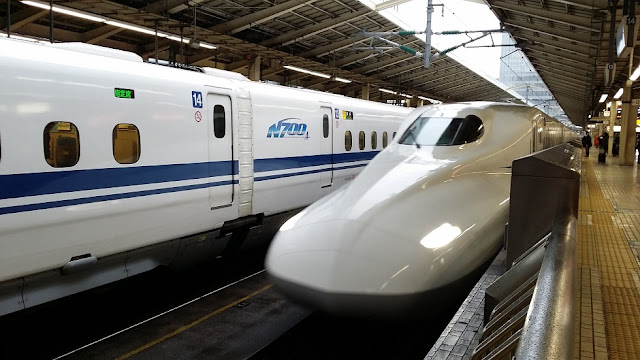 |
| Shinkansen arriving the platform |
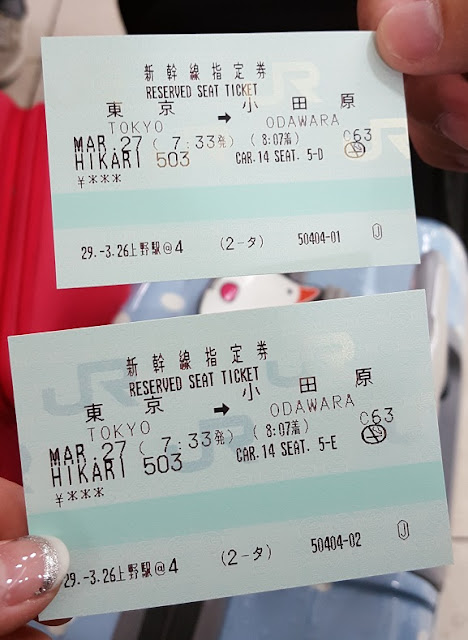 |
| Shinkansen Reserved Seat Tickets |
Shinkansen (新幹線)
The Shinkansen is a symbol of Japan's modern, efficient and hi-tech society. It has a brilliant operational safety record and has one of the world's highest annual passenger ridership for high speed rail network. Most visitors to Japan will typically choose the Shinkansen for inter-city travel, which is comfortable, convenient and fast. It can travel at a maximum speed of around 320 km/hr. For example, our trip from Tokyo Station (東京駅) to Odawara Station (小田原駅) takes around 30 min only. There is one problem we faced when we boarded the train. The carriage has no dedicated storage space for large luggage. For smaller bags and luggage, we could still put it at the overhead ledge. But for bigger items, we had to placed them at our seat. Yes, the leg space of the seat is quite generous, so we could put the luggage at the expense of our leg space.
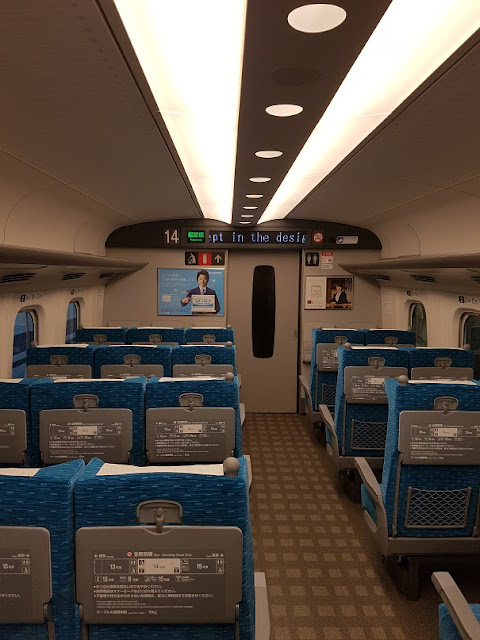 |
| Seating arrangement inside the Shinkansen Hikari train |
Since we had woke up so early in the morning, most of us made use of the travelling time to take a short nap.
Odawara Station (小田原駅)
Odawara (小田原) itself is not a big city, but the train station has considerable large number of passengers, due to many visitors travelling to Hakone. Odawara Station (小田原駅) serves as the main gateway to different parts of Hakone. It is also served by the Odakyu Line (also known as the "Romancecar" service), which is a very popular route for visitors making a day trip to Hakone, coming from Shinjuku (新宿) in Tokyo. From here, there are 2 main ways to get to the Hakone area. The first is by the Hakone Tozan Railway and the second by the Hakone Tozan Bus Services.
Odawara (小田原) itself is not a big city, but the train station has considerable large number of passengers, due to many visitors travelling to Hakone. Odawara Station (小田原駅) serves as the main gateway to different parts of Hakone. It is also served by the Odakyu Line (also known as the "Romancecar" service), which is a very popular route for visitors making a day trip to Hakone, coming from Shinjuku (新宿) in Tokyo. From here, there are 2 main ways to get to the Hakone area. The first is by the Hakone Tozan Railway and the second by the Hakone Tozan Bus Services.
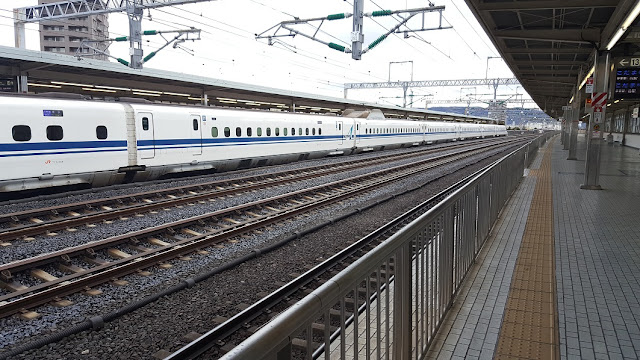 |
| Arrived at Odawara Station |
Before we depart for our tour, we had arranged to meet-up with our Hakone Airbnb host at the station, which he had offered to transport our luggage by his private car directly to his house in the afternoon, at no additional charges! He is definitely the best Airbnb host I had ever encountered. After we off-loaded our luggage, we visited the Odakyu Sightseeing Service Centre to purchase the 2-Days Hakone Free Pass. The pass provides unlimited use of Odakyu affiliated buses, trains, boats, cable cars and ropeways in Hakone area, including discounted admission to selected tourist attractions.
 |
| Hakone Free Pass |
After all this, we exited the station by the east exit to the bus stop to take the Hakone Tozan Bus T to Togendai Station (桃源台駅). The bus ride will take around 1 hour.
Hakone Venetian Glass Museum (箱根ガラスの森美術館)
Along the way, the bus ride winds up and down along the river valley and hillside of Hakone region. Most of all actually fell asleep during the bus ride, until somewhere near the Hakone Venetian Glass Museum (箱根ガラスの森美術館), where we saw something exciting, snow! We had never expected to see snow during this Japan trip, since it was already Spring time. Probably due to the higher altitude in the mountainous area, it was still snowing during the early Spring time in Hakone. For most of our group, it was their first time seeing snow. We made an instant decision to alight the bus to enjoy the snow experience.
Since we were already at the doorstep of the Hakone Venetian Glass Museum (箱根ガラスの森美術館), we decided to visit the attraction.
 |
| View of Odawara Castle en-route to the bus stop |
Hakone Venetian Glass Museum (箱根ガラスの森美術館)
Along the way, the bus ride winds up and down along the river valley and hillside of Hakone region. Most of all actually fell asleep during the bus ride, until somewhere near the Hakone Venetian Glass Museum (箱根ガラスの森美術館), where we saw something exciting, snow! We had never expected to see snow during this Japan trip, since it was already Spring time. Probably due to the higher altitude in the mountainous area, it was still snowing during the early Spring time in Hakone. For most of our group, it was their first time seeing snow. We made an instant decision to alight the bus to enjoy the snow experience.
Since we were already at the doorstep of the Hakone Venetian Glass Museum (箱根ガラスの森美術館), we decided to visit the attraction.
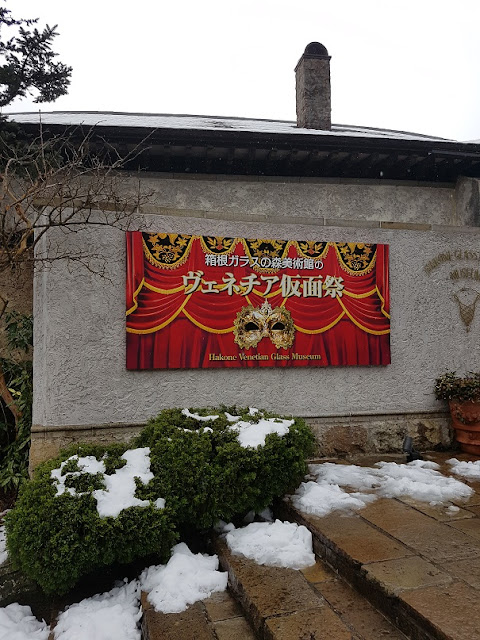 |
| Hakone Venetian Glass Museum |
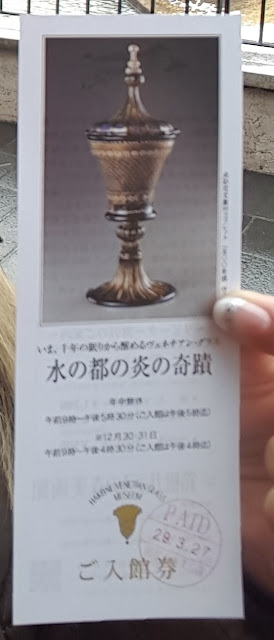 |
| Entrance ticket |
After we bought the tickets at the entrance (which comes with a discount with the Hakone Free Pass), we entered an outdoor garden. The scenery here was beautiful, with a lake in middle, several Italian-styled buildings, glass sculptures, a great backdrop against the mountain and everywhere partially covered with snow. We spared no time to take lots of photos here.
After the tour in the garden, we proceeded to the main museum building. The museum displays hundreds of exquisite modern and classical Venetian glassware. Visitors could actually rent the traditional Venetian costumes and masks to tour the museum, which makes you feel exactly like in Venice!
At the end of the museum, there is a museum shop, which sells different kinds of glass products and accessories from Venice and other parts of the world.
After the tour in the garden, we proceeded to the main museum building. The museum displays hundreds of exquisite modern and classical Venetian glassware. Visitors could actually rent the traditional Venetian costumes and masks to tour the museum, which makes you feel exactly like in Venice!
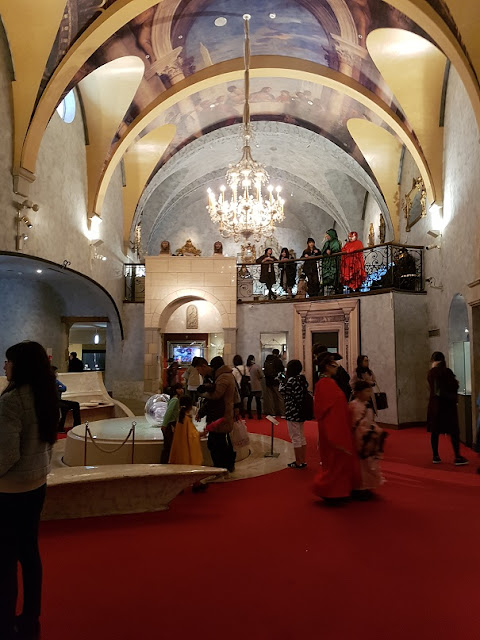 |
| Inside the museum, with many visitors in Venetian costumes |
At the end of the museum, there is a museum shop, which sells different kinds of glass products and accessories from Venice and other parts of the world.
 |
| Museum Shop |
After the museum tour, we went back to the bus stop to take the next Hakone Tozan Bus T to continue our journey to Togendai Station (桃源台駅).
Togendai Station (桃源台駅)
Togendai Station (桃源台駅) is an important interchange point in Hakone. Located just by the side of Lake Ashi (芦ノ湖), there's a ferry terminal that serves the Hakone Sightseeing Cruise across the Lake Ashi (芦ノ湖). It is also the terminal station for several Hakone Tozan bus services and the ropeway to the Owakudani (大涌谷).
Togendai Station (桃源台駅)
Togendai Station (桃源台駅) is an important interchange point in Hakone. Located just by the side of Lake Ashi (芦ノ湖), there's a ferry terminal that serves the Hakone Sightseeing Cruise across the Lake Ashi (芦ノ湖). It is also the terminal station for several Hakone Tozan bus services and the ropeway to the Owakudani (大涌谷).
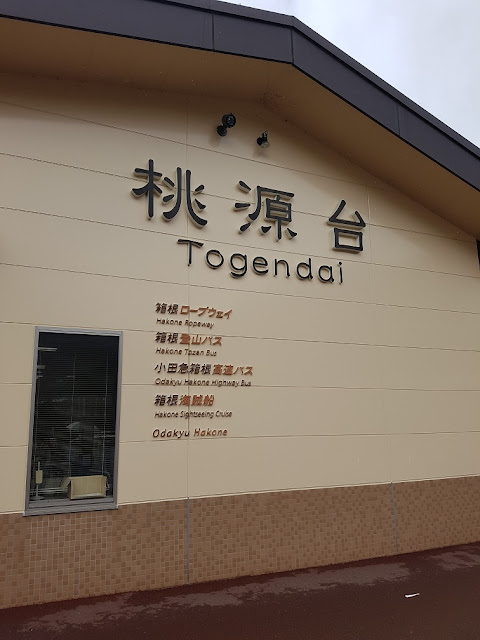 |
| Togendai Station |
 |
| Ropeway and Hakone Tozan Bus |
As it was already lunch time when we reached there, we went straight to the Togendai View Restaurant (桃源台绝景餐厅) to have our lunch. The restaurant has a large seating area, which could accommodate quite a lot of people. The best seats are along the window where we could enjoy the great scenic view of Lake Ashi (芦ノ湖) while we have our meals. Ordering is self-service here and most of us ordered the Rice Omelette, Pork Cutlet Curry Rice and Hamburger Steak Set.
Owakudani (大涌谷)
After lunch, we went to the 2nd level to take the Hakone Ropeway to visit Owakudani (大涌谷). Owakudani (大涌谷) is a volcanic valley and a very popular tourist attraction, famous for its scenic views (Mount Fuji can be seen here on clear skies), the constant spewing of the sulphur gas from the vents and the Kuro-Tamago (or known as "Black Egg"), hard-boiled egg cooked in the hot springs. It is strongly advised that people with asthma, heart disease and pregnant women should avoid going to the volcanic valley, due to high concentrations of sulphur in the air. Owakudani (大涌谷) can be accessed by the ropeway from 2 sides. The Togendai (桃源台) end (which was our route) or the Gora (強羅) end. Our original plan was to travel to Owakudani (大涌谷) from Gora (強羅). But due to the closure of the stretch of ropeway between Sounzan and Owakudani stations, (although substitute shuttle bus services were available), we had now planned to travel to and back from Togendai Station (桃源台駅).
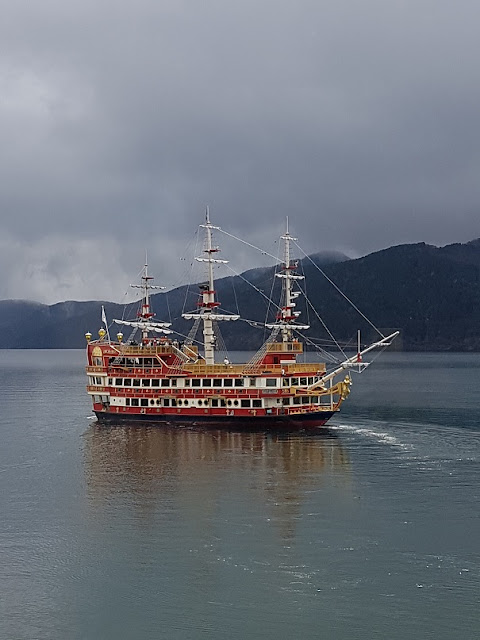 |
| View of Lake Ashi Sightseeing Cruise from Togendai View Restaurant |
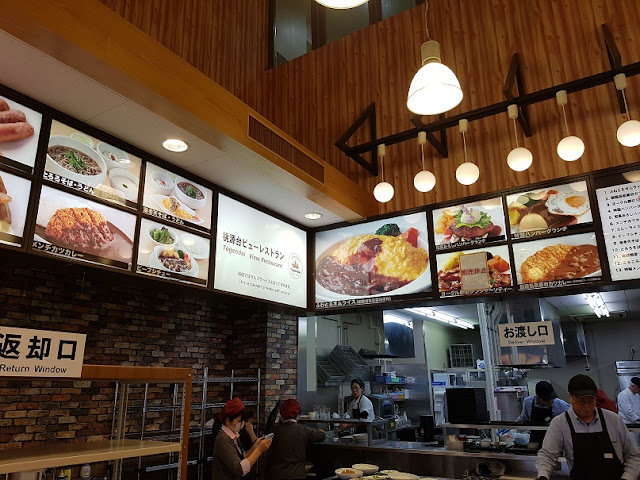 |
| Togendai View Restaurant Menu |
 |
| Togendai View Restaurant Menu Display |
 |
| Hamburger Steak Set |
Owakudani (大涌谷)
After lunch, we went to the 2nd level to take the Hakone Ropeway to visit Owakudani (大涌谷). Owakudani (大涌谷) is a volcanic valley and a very popular tourist attraction, famous for its scenic views (Mount Fuji can be seen here on clear skies), the constant spewing of the sulphur gas from the vents and the Kuro-Tamago (or known as "Black Egg"), hard-boiled egg cooked in the hot springs. It is strongly advised that people with asthma, heart disease and pregnant women should avoid going to the volcanic valley, due to high concentrations of sulphur in the air. Owakudani (大涌谷) can be accessed by the ropeway from 2 sides. The Togendai (桃源台) end (which was our route) or the Gora (強羅) end. Our original plan was to travel to Owakudani (大涌谷) from Gora (強羅). But due to the closure of the stretch of ropeway between Sounzan and Owakudani stations, (although substitute shuttle bus services were available), we had now planned to travel to and back from Togendai Station (桃源台駅).
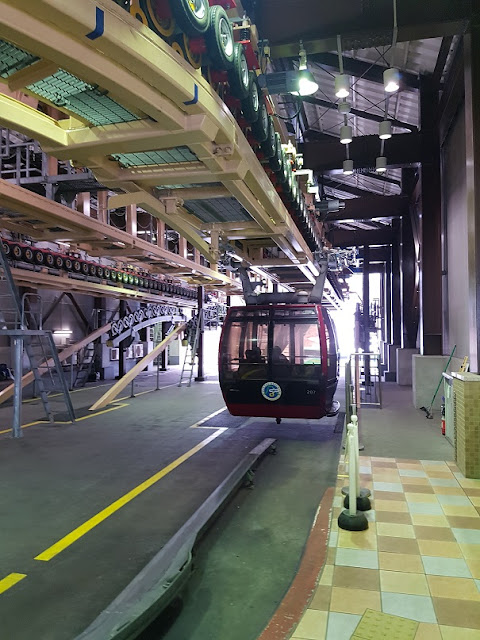 |
| Waiting for the Hakone Ropeway ride at Togendai Station |
The ropeway ride will pass by the Ubako Station (姥子駅), before reaching the Owakudani Station (大涌谷駅). Between Ubako and Owakudani stations, the ropeway ride was supposed to offer the best view of Mount Fuji. Unfortunately, that day it was too cloudy and we could not see any glimpse of the great mountain. But on the other hand, another surprise greeted us, the sky started snowing which we were thrilled! When we arrived at Owakudani (大涌谷), we could see the entire volcanic valley covered with snow.
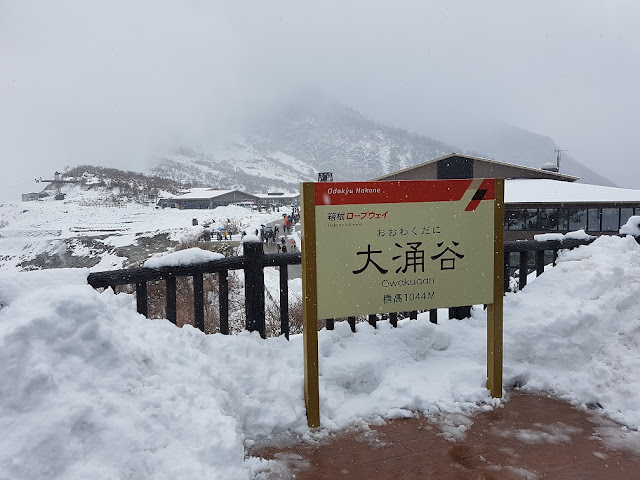
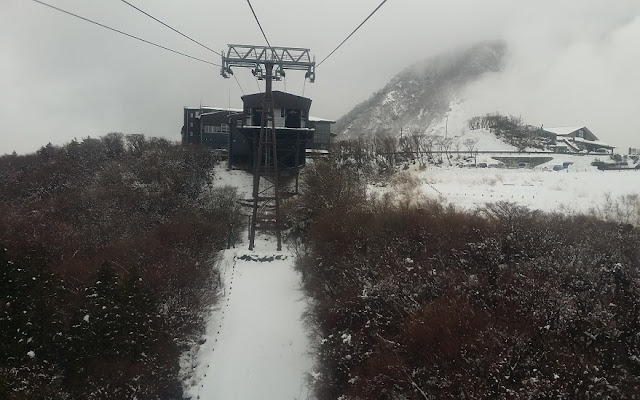 |
| Approaching Owakudani Ropeway Station |
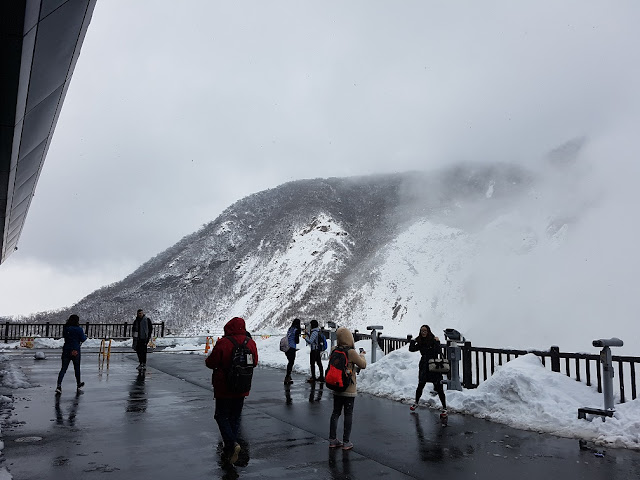 |
| Outside Owakudani Ropeway Station |

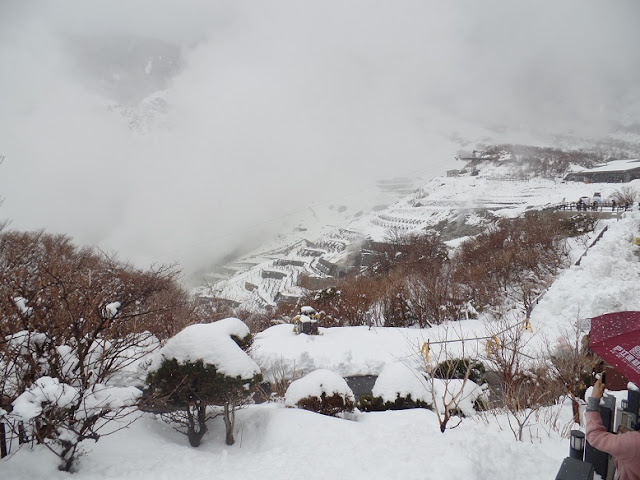 |
| The volcanic valley |
The entire area isn't very big. There are several lookout points to enjoy the scenery. Further down from the ropeway station, there's a Hakone Geomuseum (箱根ジオミュージアム) which displays information and exhibits about the history, geography, habitat and dangers of the Hakone Volcano.
 |
| View of Owakudani Ropeway Station |
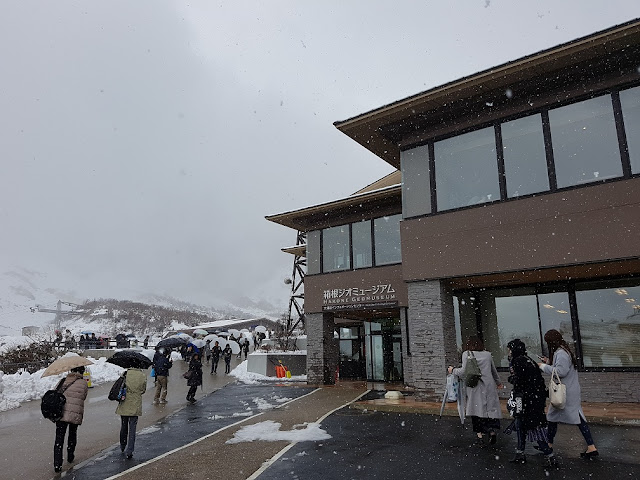 |
| Hakone Geomusuem |
 |
| View of the ropeway towards Sounzan Station |
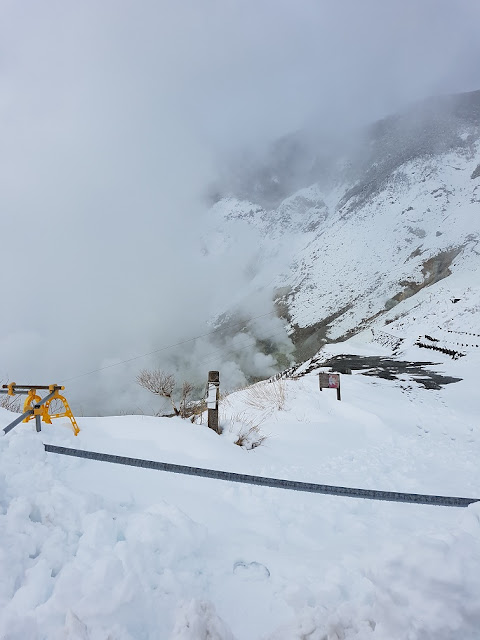 |
| Constant spewing of sulphur gas from the vents |
Adjoining the museum is a shop (Owakudani Kurotamago Kan) beside the carpark area selling souvenirs, snacks and the famous Kuro-Tamago.
 |
| Black Egg Sculpture in front of the shop |
 |
| Hello Kitty in Black Egg |
During the good days, the hiking trail will also be opened, which visitors could travel further down into the valley. After some time playing in the snow and shopping of the Kuro-Tamago, we took the ropeway back to the Togendai Station (桃源台駅).
Lake Ashi Sightseeing Cruise
After we reached the Togendai Station (桃源台駅), we went to the adjoining port directly to queue up for the ferry ride on the Lake Ashi Sightseeing Cruise.
Lake Ashi Sightseeing Cruise
After we reached the Togendai Station (桃源台駅), we went to the adjoining port directly to queue up for the ferry ride on the Lake Ashi Sightseeing Cruise.
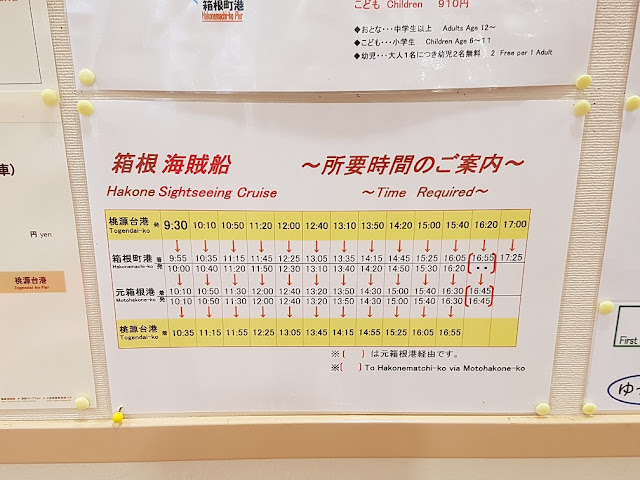 |
| Schedule of the Lake Ashi Sightseeing Cruise |
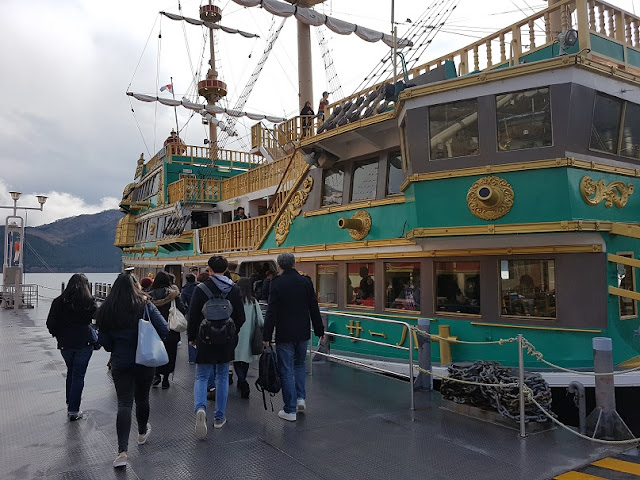 |
| Boarding the cruise |
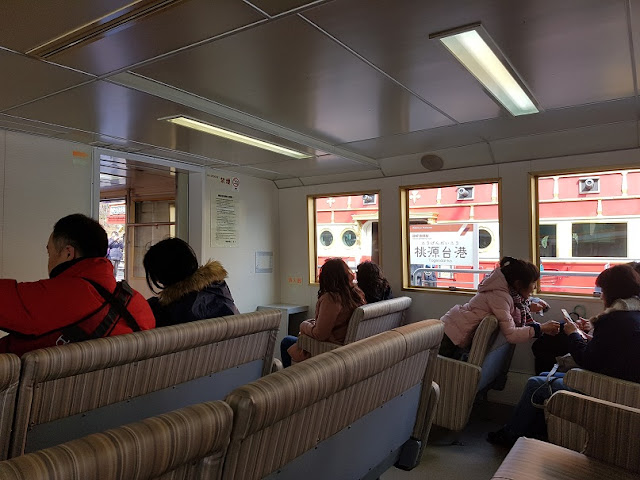 |
| Interior of the cruise ship |
The cruise ride will bring us across Lake Ashi (芦ノ湖) to Hakone-Machi Port (箱根町港) in the south, which takes approximately 30 min. Lake Ashi (芦ノ湖) is actually a crater lake within the caldera of the Hakone Volcano.
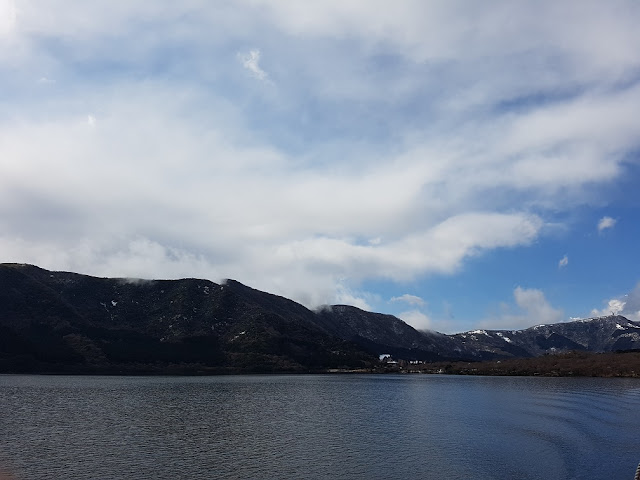 |
| Scenic view around Lake Ashi |
The design of the cruise ship is very unique and colourful, which looks like a pirate ship. There's a lot of seats inside, but most passengers would crowd around the open deck area to enjoy the breeze and the scenic view of the surrounding landscape.
Airbnb at Ohiradai (大平台)
The original plan after reaching Hakone-Machi Port (箱根町港) was to visit the nearby Hakone Check Point/Sekisho Exhibition Hall (箱根関所資料館) and the Ancient Cedar Avenue (旧街道杉並木), but due to the earlier insertion of the visit to the Hakone Venetian Glass Museum (箱根ガラスの森美術館), we had run out of time as we need to return to our Airbnb house to meet-up with the host to check-in. We took the Hakone Tozan Bus H from the bus-stop outside the port to Ohiradai (大平台).
The house is located in a quiet neighbourhood near to the Hakone Tozan Ohiradai Train Station (大平台駅). The entire house is big, with 2 storey. It is clean and well equipped with all basic necessities like bathing essentials, heaters (we will need them since the weather was very cold), cooking utensils and Wifi etc.
 |
| Crowd on the deck of the cruise |
 |
| Shinto Shrine can be seen by the lakeside |
 |
| Arrived at Hakone-Machi Port |
Airbnb at Ohiradai (大平台)
The original plan after reaching Hakone-Machi Port (箱根町港) was to visit the nearby Hakone Check Point/Sekisho Exhibition Hall (箱根関所資料館) and the Ancient Cedar Avenue (旧街道杉並木), but due to the earlier insertion of the visit to the Hakone Venetian Glass Museum (箱根ガラスの森美術館), we had run out of time as we need to return to our Airbnb house to meet-up with the host to check-in. We took the Hakone Tozan Bus H from the bus-stop outside the port to Ohiradai (大平台).
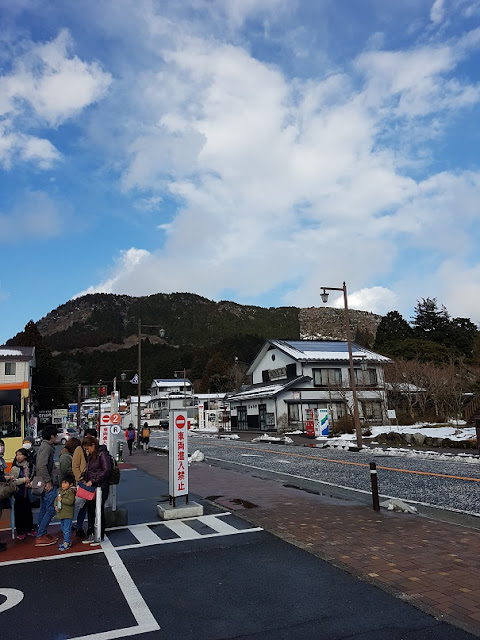 |
| Waiting at the bus stop |
 |
| Interior of Hakone Tozan Bus, with large screen to display travelling information |
The house is located in a quiet neighbourhood near to the Hakone Tozan Ohiradai Train Station (大平台駅). The entire house is big, with 2 storey. It is clean and well equipped with all basic necessities like bathing essentials, heaters (we will need them since the weather was very cold), cooking utensils and Wifi etc.
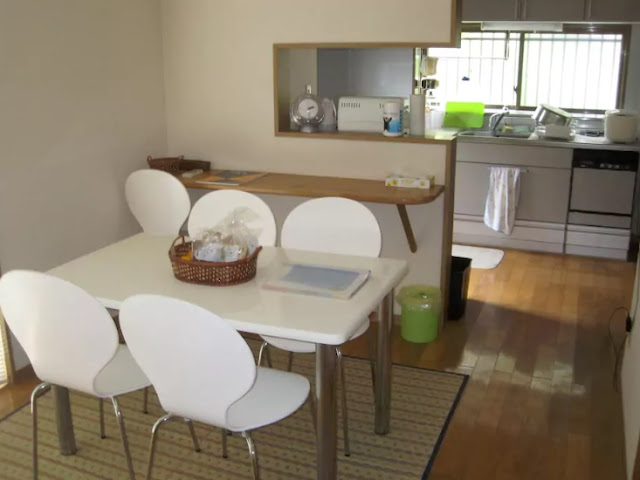 |
| The dinning and kitchen area (Source: Photo from Airbnb.com) |
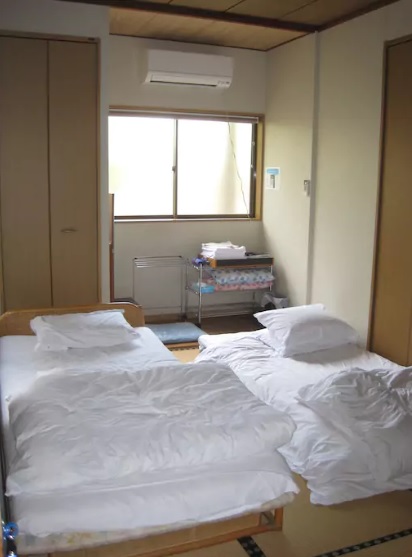 |
| Level 1 bedroom (Source: Photo from Airbnb.com) |
Our host was very nice, which he even prepared Yukata (浴衣) for us in the bedroom, fruits, and cereals, milk and bread for our breakfast the next morning!
Hot Spring at Hakone Yuryo (箱根湯寮)
After our check-in to the Airbnb, we still have one last activity for the day. A visit to Hakone is not complete without a bath in the local hot spring (also known as "onsen"). We had planned to visit the Hakone Yuryo (箱根湯寮), located at Hakone-Yumoto (箱根湯本), which is a very popular hot spring hot spring resort among the foreign and local tourists.
Hot Spring at Hakone Yuryo (箱根湯寮)
After our check-in to the Airbnb, we still have one last activity for the day. A visit to Hakone is not complete without a bath in the local hot spring (also known as "onsen"). We had planned to visit the Hakone Yuryo (箱根湯寮), located at Hakone-Yumoto (箱根湯本), which is a very popular hot spring hot spring resort among the foreign and local tourists.
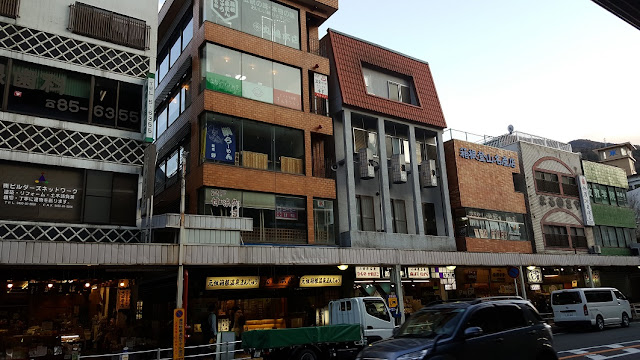 |
| Main street of Hakone Yumoto |
It is another attraction which visitors could enjoy the discount with the Hakone Free Pass. We took the Hakone Tozan Bus H to Hakone-Yumoto Station (箱根湯本駅), and from there by a short free shuttle bus ride provided by the resort.
 |
| Hakone Yuryo |
Hakone Yuryo (箱根湯寮) is located at a rustic setting along the hillside and away from the main town. Other than the hot spring, the resort also provides other services like spa, massage, and restaurants. As for the hot spring, there is 2 main types, the large communal baths (but still separates into man and woman section) and the private baths. Over here, the bath requires you to go in naked, and no swimming suite allowed. For visitors who want more privacy and not used to be seen naked with other strangers, the private bath will be suitable. There are 3 types of private baths of different sizes and prices, ranging from bath tub to mini pool. The private baths are all open-air concept, which you can see the trees and let you relax in the bath close to nature.
For us, we opted for the large communal bath. We were first led to the shoe locker area to store our shoe. Following this, we split our group to the man and woman baths, where the changing room and lockers are located. At the communal bath area, there are several facilities to enjoy, such as the indoor bath, outdoor open-air bath, pottery bath and sauna. The water temperature was at around 40+ deg C, which was not too hot compared to some other hot springs I had experienced before. We simply rotated ourselves among the different pools and facilities. At the outdoor open-air bath, it is surrounded by trees and vegetation, which makes you feel close to the nature when enjoying the bath. After the hot spring bath, you can take a shower, which the body wash and shampoo are provided. Hair-dryers are also available at the changing room area to dry up your hair.
For us, we opted for the large communal bath. We were first led to the shoe locker area to store our shoe. Following this, we split our group to the man and woman baths, where the changing room and lockers are located. At the communal bath area, there are several facilities to enjoy, such as the indoor bath, outdoor open-air bath, pottery bath and sauna. The water temperature was at around 40+ deg C, which was not too hot compared to some other hot springs I had experienced before. We simply rotated ourselves among the different pools and facilities. At the outdoor open-air bath, it is surrounded by trees and vegetation, which makes you feel close to the nature when enjoying the bath. After the hot spring bath, you can take a shower, which the body wash and shampoo are provided. Hair-dryers are also available at the changing room area to dry up your hair.
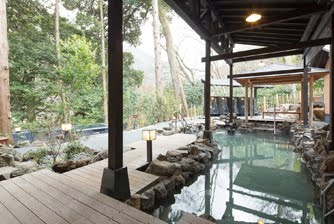 |
| Men Outdoor Communal Bath Area (Source: Photo from odakyu-travel) |
After we had changed up, we went to the common rest area called Kyusokubo to rest and waited for the girls to come out from their bath. The area is covered with Tatami floor, and visitors could also buy drinks from the vending machine outside. There were magazines and books too (which were all in Japanese) for visitors to read and relax after the bath.
Dinner
It was already late for dinner after our baths, and we decided to have our dinner at Hakone-Yumoto (箱根湯本). We took the free shuttle bus back to the town, and realised we had made a mistake when we arrived. All the shops in town were already closed. Feeling lost, we had no choice but to take the Hakone Tozan Bus H/T back to Ohiradai (大平台) to buy food from the convenience shop there. We bought mainly instant noodles and some fresh slices of pork (which we could cook at our house). Even the Kuro-Tamago (Black Egg) we had earlier bought from Owakudani (大涌谷) became addition ingredients to our noodles.
The dinner was the very last activity we had for the day, before we wash up and prepare to go to bed in the cold night.
Dinner
It was already late for dinner after our baths, and we decided to have our dinner at Hakone-Yumoto (箱根湯本). We took the free shuttle bus back to the town, and realised we had made a mistake when we arrived. All the shops in town were already closed. Feeling lost, we had no choice but to take the Hakone Tozan Bus H/T back to Ohiradai (大平台) to buy food from the convenience shop there. We bought mainly instant noodles and some fresh slices of pork (which we could cook at our house). Even the Kuro-Tamago (Black Egg) we had earlier bought from Owakudani (大涌谷) became addition ingredients to our noodles.
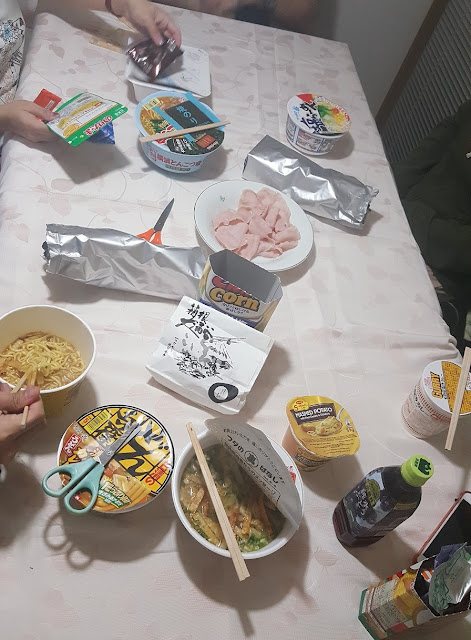 |
| Our dinner |
Follow the links below to the other days of my Japan tour:
Day 1: Ueno, JR Pass, PASMO, Nakamise-Dori Shopping Street, Senso-ji Temple, Tokyo One Piece Tower
Day 2: Shinkansen, Odawara, Hakone Free Pass, hakone Venetian Glass Museum, Togendai, Owakudani, Lake Ashi Sightseeing Cruise, Hakone Yuryo, Onsen
Day 3: Kyoto, Fushimi Inari Shrine, Kiyomizu-dera Temple, Gion, Pontocho
Day 7: Hiroshima, Tram, Miyajima, Giant Torii Gate, Sika Deer, Itsukushima Shrine, Atomic Bomb Dome, Hiroshima Peace Memorial Park, Hiroshima Peace Memorial Museum, Hondori Street, Okonomiyaki
